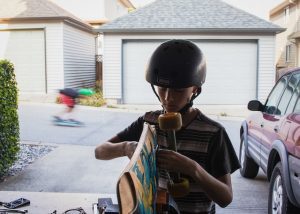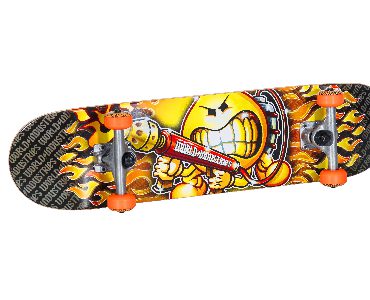We have all felt the thrill of cruising and skateboarding smoothly on a park trail. The wind against our faces while we go skating is relaxing. But you could actually build your cruiser skateboard and enjoy skateboarding!

Intriguing, right? This do-it-yourself mini cruiser board project is economical and an excellent way to customize your ride. Now, you’re not just assembling a standard skateboard but crafting a personalized ride that suits your new style and preferences. The board build process becomes a unique expression of your individuality, making each ride a truly distinctive experience.
At FamilyHype, we believe in nurturing our passions and sharing them with those around us. That’s why we are here to guide you every step of the way in constructing your very own cruisers. From understanding the basics about skateboards, gathering materials and hardware tools, designing and constructing them, to final customizations, testing, and adding personal touches, check out our blog to learn how to build a custom skateboard uniquely yours. We’re here to help you create not just a skateboard but a reflection of your style and the joy of crafting your skateboard setup.
Let’s roll up our sleeves and turn that dream board into reality!
Key Takeaways
This article will teach us how to make cruisers from scratch and build you best cruiser skateboard setup, the importance of maintenance, and the many types available, such as longboard, street, and retro cruisers. We will also gain an appreciation for the skateboarding community, the art of skateboarding, and the various tricks and techniques associated with it.
As we progress, adjustments to our boards may be necessary to align with our unique style. FamilyHype emphasizes the importance of continuous learning, experimentation, and, above all, savoring the exhilarating journey of skateboarding and a cruiser board as a united experience!
Perfect Cruiser Skateboard

Before you make your own best cruisers, it’s crucial to understand the basics of this type of skateboard and why they’re the go-to choice for smooth, effortless rides. Once you’ve grasped the essentials of your skateboard setup, the rest of the process, from gathering materials and tools to designing, constructing, final customizations, testing, and adding personal touches, will flow seamlessly.
Cruiser skateboards are a type of longboard, are available at your local skate shop. They have a different shape and a wider skateboard deck, making them a great choice for a high quality, smooth mini cruiser ride. Larger wheels and abec rating bearings also enhance speed and stability, allowing you to effortlessly maintain momentum throughout your longboard build rides.
A bit of board history reveals that its design was meant for comfort, stability, and speed. Mastering specific riding techniques will help you maximize the potential of your cruiser skateboard setup.
Now that we’ve grasped these cruiser skateboard setup basics let’s discuss the materials and tools needed for our project. You’ll be ready to take on any terrain with the right cruiser build materials and techniques.
Build A Cruiser Skateboard
Now, let’s dive into the essential part of making our cruiser longboard – gathering the necessary materials and tools.
First and foremost, selecting the right wood for our deck is paramount, as it significantly shapes the performance and durability of our board. Prioritizing high quality premium materials is strongly advised. Opting for the cheap cruiser skateboard setup option with high shipping costs and high returns rates may compromise the skateboard’s overall quality and longevity.
Then, selecting appropriate wheels, bearings, trucks and hadware is crucial for ensuring optimal performance and stability, as they affect both speed and handling on different terrains.
Right Wood For Your Cruiser Board’s Deck
Selecting the perfect wood for your deck is akin to choose the heart of Canadian maple cruisers. It’s a crucial decision in the board build process that can dramatically influence your ride.
We must consider wood sustainability and deck waterproofing, so sustainable hardwoods like maple wood, acacia, and cedar are all solid choices. These woods (like Canadian maple) offer durability yet flexibility, and when properly waterproofed, they resist damage from the elements.
Now that we’ve sorted our skateboards let’s move on to another fun part – choosing the right wheels and trucks!
Selecting Appropriate Skate Trucks
If you’re ready to build your skateboards, considering the price of wheels and trucks is important. FamilyHype is here to help you make informed decisions.
- Wheels:
- Consider the hardness of the wheels:
- Use softer wheels for rough terrain.
- Opt for harder wheels if you’ll be skating on smoother surfaces.
- Pay attention to the size of the wheels:
- Bigger wheels offer a smoother ride over cracks and pebbles.
- They maintain momentum better, which is ideal for cruising over surfaces with varying width.
- Consider the hardness of the wheels:
- Skate Trucks:
- Ensure that the truck size and length are compatible with the width of your cruiser longboard deck.
- This is particularly important for old-school decks with unique shapes and dimensions.
- Choosing the right size trucks ensures optimal performance and stability, especially when using a top mount setup.
- Consider if high trucks suit your skateboarding style, as they can affect the maneuverability and stability of your skateboard wheels and longboard build.
- Skate Safety:
- Prioritize purchasing from trusted, reliable shop brands. Some offers the best price and even offer free shipping.
- Use skateboard equipment set that meets safety standards and is suitable for your skill level.
By following these tips, you’ll be ready to roll quickly once the project completes.
Soft Wheels Vs. Hard Wheels
Soft wheels are great for a smooth and comfortable ride on various terrains, providing a bit of good shock absorption, grip, and free movement for cruising. Hard wheels are better suited for smooth surfaces, offering free increased speed and durability, making them ideal for technical tricks. Some riders even opt for a combination, using softer wheels on the front for enhanced control during turns and slides and harder wheels on the back for speed. Ultimately, finding the right balance depends on your preferences and the skateboarding you enjoy.
Cruiser Skateboard Designing
Crafting board graphic designs can be a fun and thrilling adventure. Let your creativity run wild while ensuring they match your riding style. As you embark on this creative journey, take note of the details that will make your ride visually striking and uniquely yours.
Deck graphics are essential to personalizing the board, and we recommend using sustainable materials for your mini cruiser build. Your design should be stylish and considerate of our planet’s health, with an eco-friendly add.
Now that you’ve got your design let’s move on to constructing your skateboard, which will bring this beautiful vision to life.
Cruiser Skateboard Building
Now that we’ve established our design let’s begin the exciting part—constructing our mini cruiser build skateboards.
We’ll start by cutting and shaping the deck to give it its unique character and ensure a comfortable ride.
Then, we’ll assemble the wheels and trucks, which will require careful precision to ensure a good build, but don’t worry—we’ll do this together!
Cutting And Shaping The Deck
It’s time to learn the art of cutting and shaping your deck, the heart of your project! Once you’ve decided on the right plywood thickness and applied the proper deck sanding techniques, you’ll ensure a smooth ride. Remember that the deck materials should be durable and not break easily. This attention to quality ensures the safety of your ride and the longevity of your handcrafted board.
To shape the deck of your board, begin by marking and cutting the desired dimensions using a circular saw or jigsaw. Smooth edges and corners with sandpaper, and apply finishing touches like paint or grip tape. Drill holes for truck attachment if needed, ensuring accuracy. Thoroughly inspect for imperfections, making necessary adjustments.
The wheels and trucks are assembled next in our lineup to ensure our board rolls smoothly.
Assembling The Wheels And Trucks
Let’s shift gears and delve into the next critical stage of your cruiser longboard project: assembling the wheels and trucks.
When choosing street wheels, you should opt for high durability for long-term use. Next, securely attach each wheel-truck, ensuring your truck’s alignment is correct for smoother rides. Finally, make sure to tighten all components firmly, including the risers, but not excessively. You can easily adjust new risers based on your size width preference.

Now, it’s time to add your flair by customizing the skateboards. Remember that the overall focus of this article is to provide you with the expertise to assemble a skateboard, so make sure to take the necessary steps to create a thrilling ride and view your progress.
Cruiser Skateboard Customization
Now that we’ve assembled our cruisers, it’s time to add some personal flair! We’ll explore how to gear up and apply grip tape for added stability while showing off your style. We’ll also discuss the ins and outs of painting and personalizing your deck. So grab your creativity hat because we’re about to make your ride unique.
Adding Grip Tape To Your Cruise Boards
Slapping on some grip tape is the next step in your DIY project, and believe me, it’s easier than you might think. You can make your board truly unique and let your personality shine through with the help of some grip tape. Don’t settle for cheap or low-quality products; invest in high quality grip tape that not only provides excellent traction but also adds a touch of style to your skateboard.
Here are a few tips to help you along the way:
- Explore grip tape alternatives – not all tapes are created equal. Consider grip tape options such as bubble grip tape, anti-slip grip tape, or even glow-in-the-dark grip tape for a unique look.
- Learn different tape application techniques – practice makes perfect. Try overlapping, layering, or criss-crossing techniques to get the best results. This will provide an extra layer of protection to your ride, making sure that you are safe as you ride. It doesn’t matter where you go. Whether you want to ride in the busy city landscape or in rural areas, a properly applied grip tape is key to safety!
- Remember to smooth out bubbles for an even surface. Applying pressure with cloth or squeegee can help with this. A fiber cloth is a good option for wiping boards because they don’t leave any residue. Once you’ve mastered the basics, you can experiment with different colors and designs to create a truly personalized your board.
Painting And Personalizing Cruise Skateboard Deck
Unleashing your inner artist on your skateboard deck is the next thrilling phase of this project. FamilyHype encourages creativity and self-expression, so why not take your skateboards to the next level with some fun deck stenciling? Choosing blue clear color combinations that reflect your style will make the board truly yours.

Skateboards are a great way to express yourself, and with the right techniques, you can make your board stand out from the crowd. You can customize your board with unique art and design elements, including stenciling, airbrushing, and decals. Don’t forget about the option of adding stickers for an extra touch of mini cruiser personalization. If you need guidance, consider watching video tutorials on YouTube for step-by-step instructions. With the right materials and approach, you can create a one-of-a-kind board that truly reflects your style and personality.
So let’s add those personal touches to your board build, shall we? After all, creativity is an act of service to self-expression! We’d love to hear about your experiences and what works best for you when you build a board.
It’s time to take our personalized skateboards out for a spin and fine-tune their performance.
Cruiser Skateboard Testing & Adjusting
Let’s dive right into the critical next step: testing and adjusting.
Before hitting the pavement, conduct a thorough safety check to ensure everything is in place and working as it should.
Then, make the necessary tweaks and adjustments to guarantee that smooth ride you aim for – because nothing beats skating on a board that feels just right!
Cruiser Skateboard Safety Check
Conducting a safety check before you hit the pavement on your new board is crucial to ensuring a smooth and stable ride.
It’s important to remember that injury prevention is key. Here are some safety checks to ensure you have a safe and enjoyable ride:
- Ensure all nuts and bolts are tight.
- Check your wheels for any damage.
- The importance of wearing helmet can’t be overstated; always wear one.
- Make sure your board isn’t cracked, warped, or poorly set.
- Check that the grip tape is properly adhered.
Skateboarding safety is paramount; following these steps before riding can help prevent accidents and injuries.
Making Adjustments For A Smooth Cruiser Skateboard Ride
After the safety check, fine-tune your board for optimal performance and comfort. Pay close attention to the board build and its flexibilities, and adjust them according to your rider’s stance. Balanced flexibility ensures a smoother ride, while an ideal stance provides better control.
Remember that skateboard components such as trucks, wheels, bearings, and decks are the primary components that can affect the quality of the ride. For example, trucks should be light and responsive, wheels should offer adequate grip and speed, bearings should be low-friction, and decks should be flexible yet durable. Attention to these details ensures that your board is tuned to the edge, providing an optimal and enjoyable riding experience.
Remember, we’re crafting the skateboards for ourselves and to serve others who share our passion for skateboarding. If you find this blog article helpful, please share your feedback with us. We’d love to stay up to date and hear latest news from you! You can also check our other posts for reference.
Conclusion
Experts recommend that when constructing your cruiser board, is not just about piecing together wood and wheels; it’s an immersive journey into the world of skateboarding that allows you to express your unique style and creativity. From selecting the right materials to applying your final, personal touches, each step of your cruiser build offers an opportunity to deepen your understanding and appreciation for the art of mini cruiser boarding.
With the guidance from this article, you will be well-equipped to build a board that is both functional and a true reflection of your individuality. Embrace this DIY project as a chance to innovate, learn, and ultimately enjoy a riding experience entirely alone.
Frequently Asked Questions (FAQs):
Which Is Harder, A Kickflip Or Ollie?
A kickflip is generally considered harder than an ollie. It involves a more complex motion and requires mastering the flick of the board with your foot while jumping and leveling it.
Can You Do Tricks On A Cruiser Skateboard?
While cruiser boards are primarily designed for smooth cruising and transportation, some tricks can still be performed on them, especially if they have a board setup that allows for it. Tricks like ollies, manuals, and even some basic flip tricks can be done on a cruiser board, particularly if it has small and hard wheels similar to regular skateboard wheels. However, it’s essential to remember that they are not specifically built for tricks, and their performance in this area may not match that of a traditional one with a cheap skateboard deck.
How Do You Cruise Faster On A Skateboard?
To cruise faster on a skateboard, consider upgrading to wheels with a higher durometer rating on the durometer scale, as they offer less friction and roll more efficiently. Additionally, ensure that your bearings are clean and well-maintained, as smooth bearings help reduce resistance. Consider adjusting your trucks to tighten them for sharper turns and better control. The Landyachtz Dinghy is a popular cruiser board known for its smooth ride and maneuverability, making it a suitable option for those looking to cruise faster.
How Do You Slow Down A Cruiser Skateboard?
To slow down cruiser boards, you can employ several techniques. First, try carving or making tight turns to reduce speed gradually. Another option is to drag one foot on the ground to create friction and slow down. If you need a more cost-effective solution, consider foot braking, where you place one foot behind the board while keeping the other foot on the board to control your speed. The only issue with foot braking is that it can cause shoes to wear out quickly, but it’s a simple and effective way to slow down on a budget.
How To Make Cruiser Skateboards?
To build a custom cruiser skateboard, start with a suitable skateboard deck, which is typically broader and has a more relaxed shape for comfortable cruising. Install longboard trucks that provide stability and maneuverability for smooth rides. Use big soft wheels and riser pads that prevent wheel bite and enhance shock absorption. Finally, assemble the board with a skate tool, and you’ll have your custom cruiser board ready for enjoyable rides and easy transportation.
Can You Use A Skateboard As A Cruiser?
You can use a regular complete skateboard as a mini cruiser, but it might not be as comfortable or efficient as a dedicated skateboard. Regular ones are designed for tricks and street skating, so they usually have harder wheels and smaller decks, which can make riding on rough ground less smooth. To turn standard ones into a cruiser, you can swap the hard wheels for softer ones and use Paris trucks for better stability and a more enjoyable cruising experience.
Is It Harder To Ollie On A Cruiser?
Yes, it can be harder to ollie on cruisers than regular skateboards designed for tricks. Cruisers typically have larger, softer wheels and a higher ride height, making it more challenging to pop the board off the ground. The big wheels on some cruisers can also limit the space available for your feet to perform tricks, making ollies and other tricks more difficult to execute. However, with practice and adjustment to the cruiser’s setup and wheel wells, skaters can still perform tricks on cruisers, but they might not be as pretty easy or precise as on regular setup boards. Give yourself time to practicce.
Can You Pump A Cruiser Board?
Yes, you can pump a cruiser board. They are designed for smooth and easy riding, and with the right setup, such as using cruiser wheels like Ricta Clouds, they can provide a super smooth and enjoyable pumping experience. The soft and grippy nature of cruiser wheels bearings allows for better traction on various surfaces, making it easier to generate speed and pump the wheel board for a more fluid ride on your board.
How Are Graphics Put On Skateboards?
Graphics are applied to boards through a heat transfer process. The graphic is printed on special paper and transferred onto the skateboard deck using heat and pressure. This method provides a durable and cost-effective way to apply graphics to top skateboards, although they may wear off over time with extensive use.
Can You Slide On A Cruiser?
While cruiser boards are primarily designed for smooth and comfortable rides over long distances or rough terrains, they are generally not ideal for performing slides like you would on a traditional one designed for tricks and maneuvers.
Last Updated on July 1, 2024 by Allen Laconsay
DISCLAIMER (IMPORTANT): This information (including all text, images, audio, or other formats on FamilyHype.com) is not intended to be a substitute for informed professional advice, diagnosis, endorsement or treatment. You should not take any action or avoid taking action without consulting a qualified professional. Always seek the advice of your physician or other qualified health provider with any questions about medical conditions. Do not disregard professional medical advice or delay seeking advice or treatment because of something you have read here a FamilyHype.com.